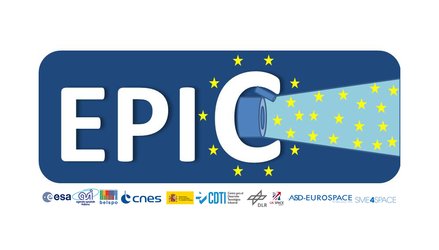What is Electric propulsion?
Electric Propulsion (EP) is a class of space propulsion which makes use of electrical power to accelerate a propellant by different possible electrical and/or magnetic means. The use of electrical power enhances the propulsive performances of the EP thrusters compared with conventional chemical thrusters. Unlike chemical systems, electric propulsion requires very little mass to accelerate a spacecraft. The propellant is ejected up to twenty times faster than from a classical chemical thruster and therefore the overall system is many times more mass efficient.
Electric Propulsion, when compared with chemical propulsion, is not limited in energy, but is only limited by the available electrical power on-board the spacecraft. Therefore EP is suitable for low-thrust (micro and milli-newton levels) long-duration applications on board spacecrafts. The propellant used in EP systems varies with the type of thruster and can be a rare gas (i.e. xenon or argon), a liquid metal or, in some cases, a conventional propellant.
Electric Propulsion System components
An Electric Propulsion System is composed by four different building blocks:
- The thruster components,
- The propellant components or fluidic management system,
- The power components, which includes the PPU,
- The pointing mechanisms (optional),
Electric Propulsion applications and type of thrusters
The different applications which currently make or may make use of Electric Propulsion Systems in the future, are:
- LEO (e.g. Earth Observation, Earth Science, constellations)
- MEO (e.g. Navigation)
- GEO (e.g. Telecommunications)
- Space Transportation (e.g. launcher kick stages, space tugs)
- Space Science, Interplanetary, and Space exploration.
For these different types of missions and requirements, the technology is faced with operational challenges in order to be able to cope with different type of maneuvers, such as: electric transfer from GTO to GEO, station keeping, interorbital transfer, interplanetary cruise, continuous LEO operations (air-drag control), (extreme) fine and/or highly agile attitude control, Long-endurance missions, etc.
A number of different Electric Propulsion Systems (EPS) exist, based on the following thrusters, (non-exhaustively):
- Gridded Ion Engine (GIE),
- Hall Effect Thruster (HET),
- High Efficiency Multistage Plasma Thruster (HEMPT),
- Pulsed Plasma Thruster (PPT),
- Magneto Plasma Dynamic (MPD) thruster,
- Quad Confinement Thruster (QCT),
- Resistojet,
- Arcjet,
- Field Emission Electric Propulsion (FEEP) thruster,
- Colloid and electrospray thrusters,
- Electrode-less thrusters
- Hollow cathode and neutralisers.
In Europe, developments have been carried out in all the different areas of electric propulsion over the last four decades. All the thrusters types mentioned above have been and/or are being developed in Europe to a certain extent. From the most mature ones (TRL8-9); the most promising technologies for Europe are HET, GIE and HEMPT.
Depending on the field of application and the specific mission requirements, a specific system level trade off should be performed to identify which thruster systems may be more or less attractive, depending on their particular thrust capabilities, electrical power consumption and other performance characteristics. The level of development and flight heritages deeply influences the final selection of a specific EPS.
Electric Propulsion opens up new opportunities for Europe
Although studied, developed and tested for several decades, certain EPS had not been readily employed in the early times of space missions mainly due to the unavailability of sufficient electrical power on board the spacecraft. Since the new century, the constantly increasing levels of electrical power on new developed spacecraft allows EP to be a very realistic and serious alternative to chemical propulsion, and the use of this technology for different type of missions is already a common practice internationally (in Europe i.e: Artemis, SMART-1, GOCE, AlphaSat , Bepi Colombo, SmallGeo, NEOSat, Electra).
For commercial satellites in the Telecommunications market, the use of EP for Station Keeping maneuvers is currently an option and in many cases a requirement for satellite manufacturers. In 2012 Boeing offered the use of EP for orbit raising and station keeping saving thousands of kilograms of mass and decreasing the satellite price and its launch by hundreds of millions dollars with its Boeing 702 platform. Since this point, European developments in this area have been accelerated.in order to offer full electric and hybrid telecommunication platforms to satellite operators. This increasing interest on EP and its associated costs benefits, together with the need for further performances and competitiveness has been transferred to the EP thrusters and the EP subsystems manufacturers and integrators.
Electric propulsion is currently considered by all space actors as a key and revolutionary technology for the new generations of commercial and scientific satellites. Initiatives in this field all over the world are aimed at the development of competitive new generations of EPS. In Europe too, all stakeholders including the European Space Agency (ESA), the National Space Agencies and industrial players have been setting efforts to develop and increase the competitiveness of the European EP technology for the different types of markets since a few decades ago.















 Germany
Germany
 Austria
Austria
 Belgium
Belgium
 Denmark
Denmark
 Spain
Spain
 Estonia
Estonia
 Finland
Finland
 France
France
 Greece
Greece
 Hungary
Hungary
 Ireland
Ireland
 Italy
Italy
 Luxembourg
Luxembourg
 Norway
Norway
 The Netherlands
The Netherlands
 Poland
Poland
 Portugal
Portugal
 Czechia
Czechia
 Romania
Romania
 United Kingdom
United Kingdom
 Slovenia
Slovenia
 Sweden
Sweden
 Switzerland
Switzerland



























